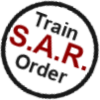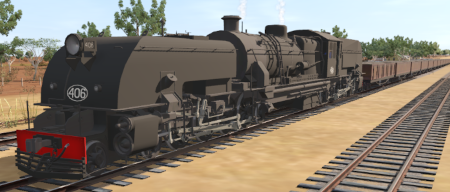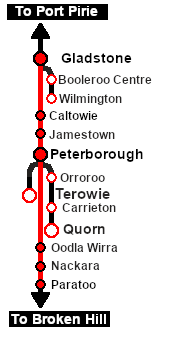| Express bulk ore freight from Broken Hill to Port Pirie. |
 |
The Historical Bit
The line from Port Pirie to Cockburn on the South Australia - New South Wales border was built in stages from 1875 to 1888 largely to capture the lead, zinc and silver ore traffic from the mines at Broken Hill just over the border in New South Wales. Because the SAR was not allowed to operate into New South Wales, a private railway, the Silverton Tramway, was created to carry the ore across the border. The SAR and Silverton Tramway simply swapped locos at Cockburn on the border. It was called a "tramway" to get around a NSW law banning private railways but not private tramways. Despite the title it was a fully operating heavy haul narrow gauge railway.
The SAR had a monopoly on the ore traffic until 1919 when the NSWGR (New South Wales Government Railways) completed its own line to Broken Hill but the SAR continued to carry the bulk of the ore because the port and smelter at Port Pirie was much closer to Broken Hill.
By 1970 the narrow gauge line had been converted to standard gauge and the Silverton Tramway ceased its ore hauling operations. Today, more than a century after it was formed, the Silverton Company, as it is now known, is still providing shunting services at Broken Hill and motive power to rail operators.
Getting Started:
- If you have already closed the opening message window then the first step is to pause the session by pressing the P key.
- Next locate your loco. Either:-
- Open the Finder Tool (press Ctrl F ) and type, in the Name field, the name of the loco. For example SAR 406 (or just 406 should be enough). Click the tick icon, OR
- Open the Driver List (bottom left of the screen) and select the loco from there - click the drivers Eye icon to jump to the loco.
- Take a few moments to get your bearings. Click
 (this link will open in this window) to show the location details and track plans for Paratoo. In each location details page:- (this link will open in this window) to show the location details and track plans for Paratoo. In each location details page:-
- the
 tab gives an overall summary of each location with a "potted" history (where available). tab gives an overall summary of each location with a "potted" history (where available).
- the
 tab reveals the invisible tab reveals the invisible  Track Marks for Drive To commands. Track Marks for Drive To commands.
- the
 tab lists all active industries and their commodities. tab lists all active industries and their commodities.
- the
 tab describes the names, locations and settings of all junction switches as well as some switch sets you may want to use. tab describes the names, locations and settings of all junction switches as well as some switch sets you may want to use.
- Each location details page has direct links to the adjacent locations so you can explore along the route.
- When you are ready to start, reload the Peterborough Base Session page (click the Scenarios button on your current location page) and select this Scenario again or just use the Back button on your browser - whichever is quicker.
- Switch back to TRS19 Driver and either close the opening message window or press the P key to start the session.
|
|
Tutorial:
 |
A tutorial on using these scenarios is provided in the link on the left. The link will open in this window |
|
Tasks:
- Move the train into Paratoo Yard on the Main Line
- Fill the tender with water at the Water Column or proceed to Nackara and fill with water at the Water Column located there.
- Proceed to Peterborough Loop or Peterborough Yard 1 .
- Detach the loco and proceed to Peterborough Main Loco Fuel & Water Point to refuel the tender with bunker c oil and water.
- Option: Reattach the loco to the train and proceed by 09:30 to Gladstone Yard.
|
 |
|
Driving Notes:
tr valign="top">
- Fuel oil level is low, but sufficient to reach Peterborough where it can be refilled
- Water is very low and you will need to refill either here at Paratoo or at Nackara
- The length of the train restricts its use of passing loops and yard loops to those located at:-
- Methuen Loop
- Nackara Station Loop and Nackara Goods
- Peechara Loop (Note that Nantabibbie Loop is too short)
- Oodla Wirra Station Loop
- Ucolta Station Loop
- Peterborough Loop, Peterborough Station and Peterborough Yard 1
- Yongala Station Loop and Yongala Goods Loop
- Belalie North Station Loop
- Jamestown Station + Yard, Jamestown Loop + Yard and Jamestown Goods Loop + Yard
- Caltowie Station Loop
- Gladstone (all loops and yards).
- The approaches to all locations are protected by invisible signals to prevent the AI Half Speed Slowdown Problem when approaching a signal at stop.
- Trackmarks and industries have been provided for AI Drive To Trackmark, Drive via Trackmark and Drive to Industry commands. Click
 for details. for details.
- Manual (no AI) driving is possible. As a visual driving aid, a Caution warning sign has been placed at the location of the Main Approach Dn and Main Approach Up trackmarks. Click
 for details. for details.
|
</tr>
|
|
|
This page was created by Trainz user pware in February 2021 and was last updated as shown below.









